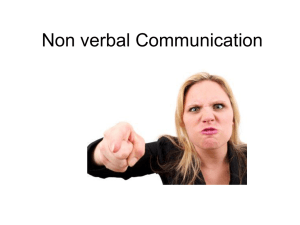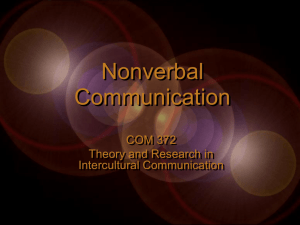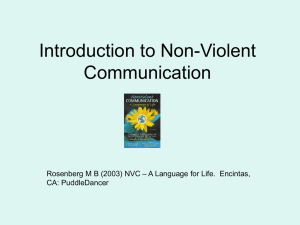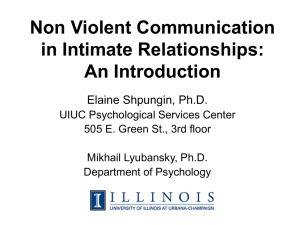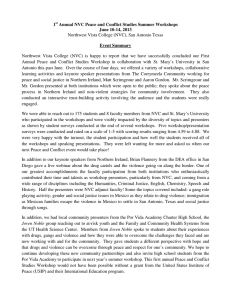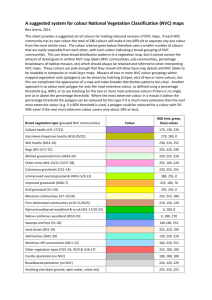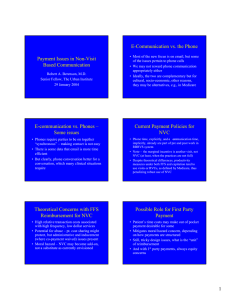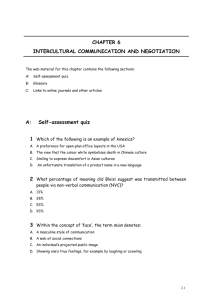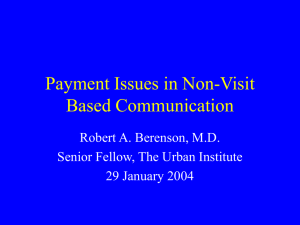NVCIntro
advertisement
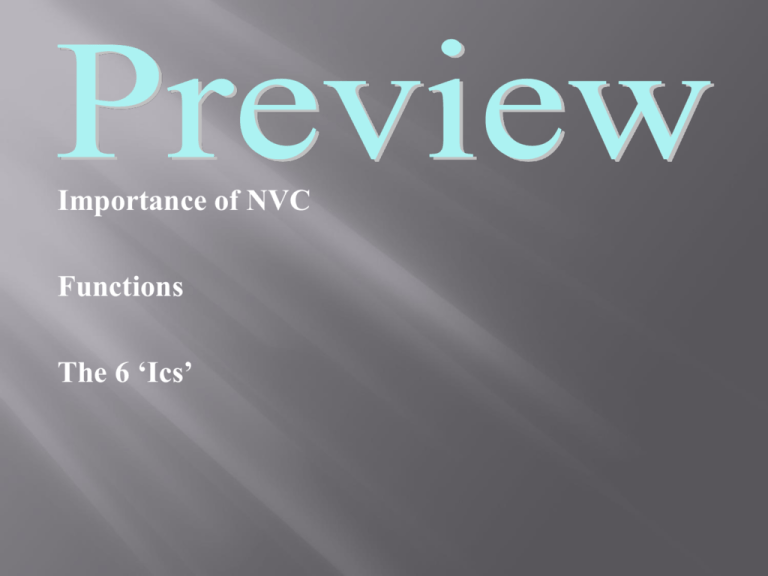
Importance of NVC Functions The 6 ‘Ics’ NVC = anything but the spoken word. 1. We cannot not communicate 2. NVC = 80 – 90% of our communication 3. Omnipresent 4. Multifunctional - part of all comm. - clarify meaning of verbals, emotional state 5. Universal Language System - smile, cry, point - basic understanding 6. Misunderstanding - make sense of world, or cause problems 7. Phylogenetic Primacy ~ NVC predates language ex. Cavemen ~ cave drawings, grunts. . . 8. Ontogenetic Primacy ~ interaction with your caretaker and the environment (babies) ex. How does a baby signal they need food, or to get out of a poopy diaper? 9. Interaction Primacy ~ 1st form of communication ~ before we speak, we give visual cues. . . Ex. physical appearance, eye contact, smells, colors you wear. . . 10. Express what verbal communication can’t or shouldn’t ex. Getting your groove on at a dance. . . Look longingly at a hottie, they look at you weird = you don’t have to go over and embarrass yourself 11. NVC is trusted Why? 1. We cannot not communicate 2. NVC = 80 – 90% of our communication 3. Omnipresent 4. Multifunctional - part of all comm. - clarify meaning of verbals, emotional state 5. Universal Language System - smile, cry, point - basic understanding 6. Misunderstanding - make sense of world, or cause problems 7. Phylogenetic Primacy ~ NVC predates language 8. Ontogenetic Primacy ~ interaction with your caretaker and the environment (babies) 9. Interaction Primacy ~ 1st form of communication ~ before we speak, we give visual cues. . . 10. Express what verbal communication can’t or shouldn’t 11. NVC is trusted 1) Send Uncomfortable Messages 2) Form Impressions which Guide Comm. 3) Make Relationships Clear 4) Regulate Interaction 5) Influence People 6) Reinforce & Modify VC The ‘ics’ help to categorize the 6 different types of Nonverbal Communication Gaze: looking at a person Eye-contact: mutual gaze, where the two look at each other at the same time Maintaining eye contact signals genuineness and adds credibility Avoiding it signals shiftiness, nervousness, and not being prepared Culturally different Very Direct eye contact: Middle Easterners, Some Latin Americans, French Moderate eye contact: Americans, Northern European, British Minimal eye contact: East Asians, Southeast Asians, East Indians, Native Americans The use of touch as communication ex. A hug, kiss, clutching hands, a slap, shove Contact: Arabs: Iraq, Kuwait, Saudi Arabia, Syria, United Arab Republic Latin Americans: Bolivia, Cuba, Equator, El Salvador, Mexico, Paraguay, Peru, Puerto Rico, Venezuela; Southern Europeans: French, Italian, Turkish Non Contact: Asian: China, Indonesia, Japan, Philippines, Thailand; Indians and Pakistanis Northern Europeans: Australia, England, Germany, Netherlands, Norway, Scotland; Americans How humans perceive, structure, and use time as communication Ex. Standing at the door when there are 5 minutes left in class. Vocal auditory behavior ∆ Not the actual words ex. Rate, pitch, volume, enunciation. . . Volume ~ loudness of voice Pitch ~ placement of voice on a scale (high low) Rate ~ speed Pauses ~ brief silence or spacing of words/sound Articulation ~ precision and clarity Enunciation ~ precision and distinctness in sounding words Rhythm ~ sense of mvmt or pacing Body Movement Excludes physical contact with another's body Watching people's actions can bring you a lot closer to the truth than merely listening to what they say (which might be a cover-up) “Science" of kinesthetics, or "body language" Can be very revealing Outward expressions of inner feelings Openness: Open hands, unbuttoned coat. Defensiveness: Arms crossed, sideways glance, touching-rubbing nose, rubbing eyes, buttoned coat, drawing away. Insecurity: Pinching flesh, chewing pen, thumb over thumb, biting fingernail. Cooperation: Upper body in sprinter's position, open hands, sitting on edge of chair, hand to face gestures, unbuttoning coat. Americans, forming a circle with thumb and forefinger to signal O.K. Culturally means: "zero" or worthless in France Money in Japan Calling someone a very bad name in Germany For Americans, up and down means yes, side to side means no In Bulgaria, the nods are reversed in meaning. How people use space to communicate. A message system used with a minimal level of awareness People may present themselves in various ways: face-to-face side-to-side back-to-back Cooperating people are likely to sit side-byside Competitors frequently face one another Competition Cooperation Conversation Proxemics is the 6th ‘ic’ that we will look at in a little more depth than the rest of the ‘ics’ Convey Attitude: Hostile vs Friendly Physical Contact: Shaking hands, touching, holding, embracing, pushing, or patting Reflect an element of intimacy or inclusiveness The distance conveys a non-verbal message. Culturally: In some cultures it is a sign of attraction, In others it may reflect status or the intensity of the exchange 1) Territoriality 2) Personal Space / Zones Claiming the rights to an area Originated from observations in the animal kingdom • Survival • Females gravitate towards males with best territory Humans communicate through proxemics as well • At Home *fences, shrubbery, flowers, *kitchen, “Dad’s chair” • In Public *purse/coat placement *reservations / tickets to a game • Male / Female interactions *toys, bling-bling, cars, cologne, perfume. . . An invisible, portable, adjustable bubble surrounding an individual. Actively maintained to protect the person from physical or emotional threats BODY BUFFER ZONE (on the test) The Zones of space which surround us 4 zones that are important in proxemic communication 1) Intimate Space 2) Communal Space 3) Socioconsultative Zone 4) Public Zone From physical contact to 18 inches 0 - 18 Usually for close relationships Various meanings *Something is wrong *Intensity *Violation of space (personal bubble) Distance from 18 inches to 4 feet 18 - 4 Interpersonal communication most common at this distance Usually friends, or acquaintances *an established relationship Spans a distance from 4 feet to 10 feet 4 - 10 Utilized in professional settings *Teacher / Student *Lawyer / Client / Jury Begins at 10 feet and extents to where one can still be seen and heard 10 - ? This type of communication tends to be formal *Public speaking *Rallies *Malls 10 Entry Observation Diary -Between now and the due date, observe 10 instances of human interaction or nonverbal communication. -Make note of environment, physical appearance, personal behavior, and interaction with others. WRITE THESE THINGS DOWN. - The completed diary is due IN CLASS on Wednesday, January 15th.
